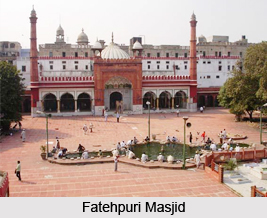 Fatehpuri Masjid is located in the city of the Delhi at the western end of the Chandni Chowk. The mosque has been built by one of the Mughal Emperor Shah Jahan`s wives, Fatehpuri Begum in the year 1650. She was from Fatehpur in whose honour the Taj Mahal was built. It is a 17th century mosque that has been designed very elegantly.
Fatehpuri Masjid is located in the city of the Delhi at the western end of the Chandni Chowk. The mosque has been built by one of the Mughal Emperor Shah Jahan`s wives, Fatehpuri Begum in the year 1650. She was from Fatehpur in whose honour the Taj Mahal was built. It is a 17th century mosque that has been designed very elegantly.
History of Fatehpuri Masjid
According to the history of Fatehpuri Masjid the Indian troops were posted here during the Sepoy Mutiny of 1857. It is said that the British had auctioned some part of the mosque after the 1857 to a Hindu merchant, Lala Channa Mal who later preserved the mosque. Later in 1877 it was purchased by the government in exchange for four villages. It was then returned to the Muslims at the Delhi Durbar. The incident took place when the Muslims were allowed to return back in Old Delhi by the Britishers. The mosque is a collection of the graves of Hazrat Nanoon Shah, Mufti Mohammad Mazhar, Maulana Muhammad Musharraf Ahmad, Dr. Muhammad Sayeed and Shah Jalal.
A similar mosque, called Akbarabadi Masjid built by the Akbarabadi Begum was destroyed by the British. The Khari Baoli, which is today Asia`s largest spice market, gradually developed after the construction of the mosque.
Architecture of Fatehpuri Masjid
The architectural design of Fatehpuri Masjid is spectacular. It has been built of red sandstone. It has a single dome and two towering minarets that have been intricately decorated and add charm and beauty to the mosque. The mosque has three gates. Khari Baoli is in the north end gate and Katra Baryan is the south gate. The courtyard made up of red sandstone resembles the Mughal architecture. The red sandstone pillars on either side of the mosque are a delight to watch. The prayer hall of the mosque is also unique and is adorned with seven arched openings. Among these arched openings the central arch is the highest one. The central arch has two large domes. The main dome has been constructed with lime mortar and embellished with black and white strips. The mosque has single and double storied apartments on the sides and some of its endowments were used as a school for poor students. The mosque has been thus traditional designed.
Fatehpuri Masjid in Delhi is open on all days. The different parts of the mosque have been beautifully decorated and are a visual pleasure. Muslim festivals Id Ul Fitr and Id ul Zuha are celebrated with great enthusiasm at the mosque. The place is located in the heart of the city hence it can be reached very easily. There are local buses, taxis and auto rickshaws which are available regularly. The nearest metro station is Delhi Main.



















